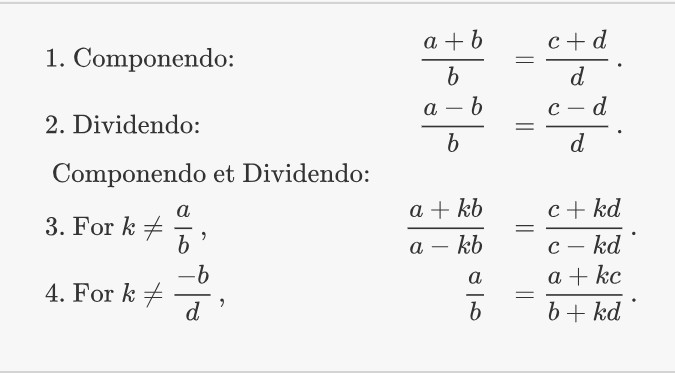Compodendo or Dividendo-RRB
Componendo and Dividendo
Componendo and Dividendo is a theorem on proportions that allows for a quick way to perform calculations and reduce the amount of expansions needed.
It is particularly useful when dealing with equations involving fractions or rational functions in mathematical Olympiads, especially when you see fractions.
Componendo and dividendo is a method of simplification in algebra, which is based on fractions that are in proportion. In this method we have 5 types of relationships
- Invertendo
- Alternendo
- Componendo
- Dividendo
- Componendo – Dividendo
- Definitions If a/b = c/d
- Invertendo : b/a = d/c
- Alternendo : a/c = b/d
- Componendo : (a+b)/b = (c+d)/d
- Dividendo : (a-b)/b = (c-d)/d
- Componendo – Dividendo : (a+b)/(a-b) = (c+d)/(c-d)
4. Example Lets see the application of Componendo – Dividendo Find the value of x in this equation
(6+x)/(6-x)=2 ?
{(6+x)+(6-x)}/ {(6+x)-(6-x)}= (2+1)/(2-1)
⇒12/2x=3
⇒6/x=3
⇒x=2
Basic rules which are very helpful to solve algebra 1 homework problems easily
Here are the rules based on componendo and dividendo-
If a,b,c and d are numbers and b,d are non zero and a/b = c/d then , the following holds:

Example:
Question – 1
If (4a + 9b) x (4c – 9d) = (4a – 9b) (4c + 9d), then the value of a:b can be equal to:
Solution:
Here we have: (4a + 9b) x (4c – 9d) = (4a – 9b) (4c + 9d).
In other words we can say that: (4a + 9b)/(4a – 9b) = (4c + 9d)/(4c – 9d)
Hence we have: {(4a + 9b) + (4a – 9b)}/{(4a + 9b) – (4a – 9b)} = {(4c + 9d) + (4c – 9d)}/{(4c + 9d) – (4c – 9d)} [By componendo and dividendo]
In other words we have: 8a/18b = 8c/18d.
Or we may write: a/b = c/d i.e. a:b :: c : d.
Hence a:b = c: d
Question – 2
For four numbers a, b, c, d if a : b = c : d, then a : c = b : d; that is, if the second and third term interchange their places, then also the four terms are in proportion.
If a : b :: c : d then a : c :: b : d.
Solution:
a : b :: c : d
⟹ a/b = c/d
⟹ a/b ∙ b/c = c/d ∙ b/c
⟹ a/c = b/d
⟹ a : c :: b : d
Question – 3
5 : 4 = 10 : 8
Solution:
Therefore, (5 – 4) : 4 = 1 : 4 = (10 – 8) : 8
Question – 4: For four numbers a, b, c, d if a : b = c : d then (a + b) : b :: (c + d) : d.
Solution: Proof:
a : b :: c : d
⟹ ab/ = cd/
Adding 1 to both sides of ab/
= cd/, we get
⟹ ab/+ 1 = cd/ + 1
⟹ a + b/b = c + d/d
⟹ (a + b) : b = (c + d) : d
Question 5: If a : b :: c : d then (a – b) : b :: (c – d) : d.
Proof:
a : b :: c : d
⟹ ab/ = cd/
Subtracting 1 from both sides,
⟹ ab/ – 1 = cd/– 1
⟹ a−b/b = c−d/d
⟹ (a – b) : b :: (c – d) : d
